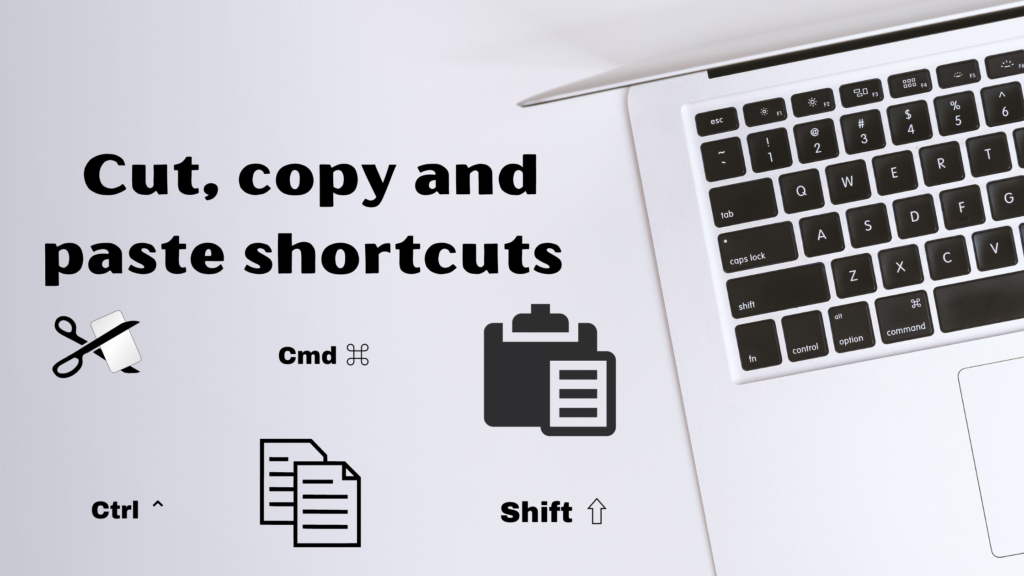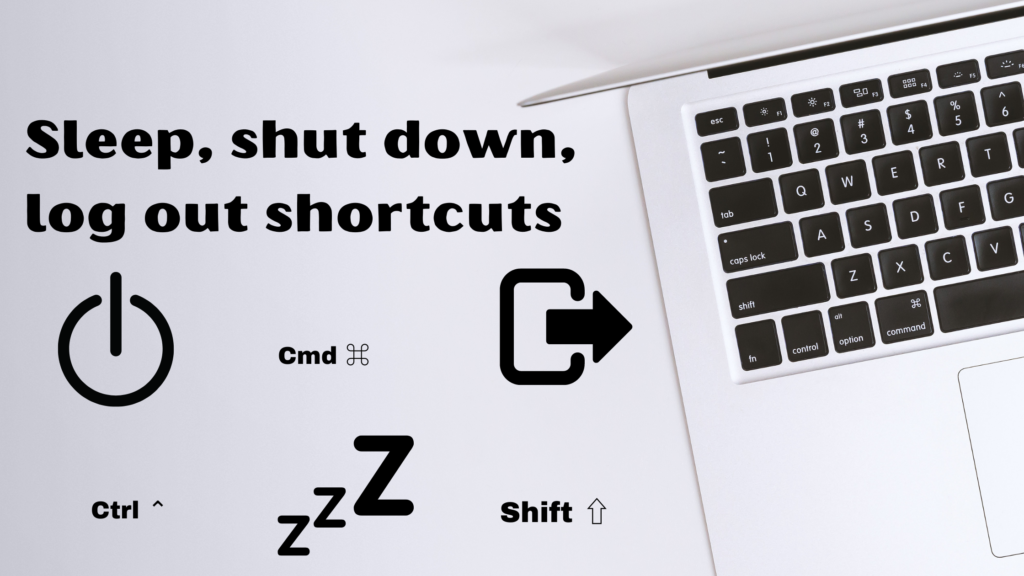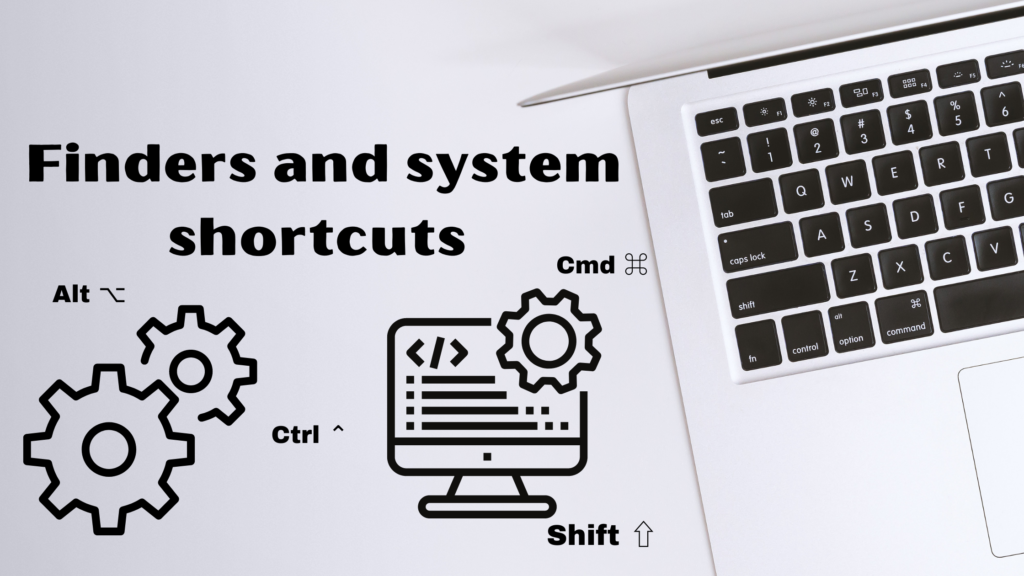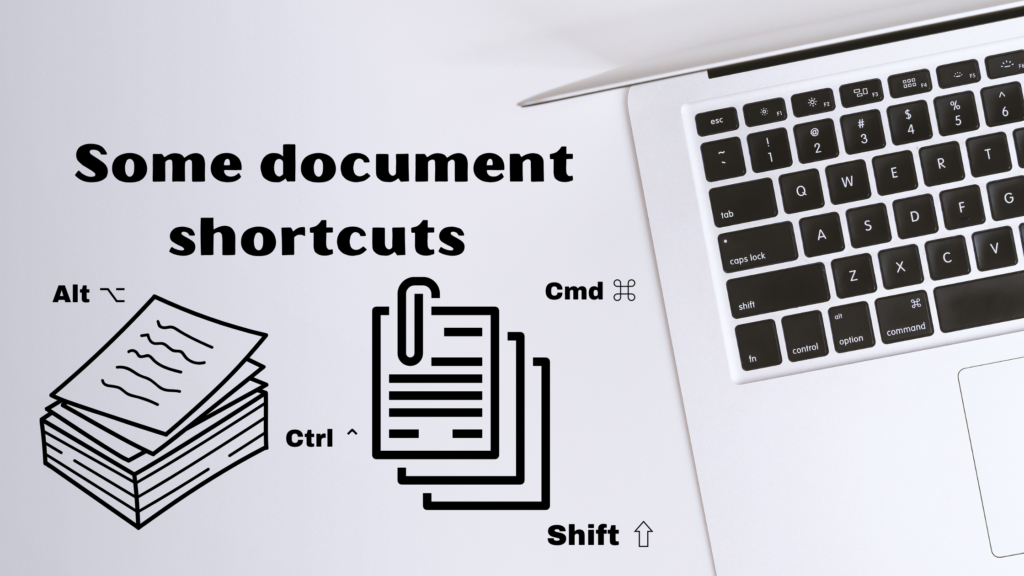List of MacBook keyboard shortcuts. For MacBook keyboard users and for nonusers too, here are the certain key combination that helps you to do some things which generally needs input devices like a mouse, trackpad, etc.
Firstly we should know how to use shortcuts, so press and hold any modifier key and then press the last key of the shortcuts to perform the function and release both keys.
Mac keyboards use some symbols including modifier keys —
- Command or Cmd ⌘
- Option (or Alt) ⌥
- Caps Lock ⇪
- Shift ⇧
- Control (or Ctrl) ⌃
- Fn

Basics shortcuts for cutting, copying, pasting and others - MacBook keyboard shortcuts
- Command X: For cutting the selected item and copying it to the Clipboard for future use.
-Command V: Paste the item that was cut or copied text. This also works for files in the Finder.
-Command C: For copying the selected item. This also works for files in the Finder.
- Command A: For selecting all the items.
- Command F: For finding items in a document.
- Command G: For finding again: find the next occurrence of the item you previously found in the document. To find any previous occurrence of the same item press, Shift-Command G.
- Command H: For hiding the window of the app you were using. To hide all other apps other than any one app, press Option Command H.
- Command M: For minimizing the window/app. To minimize all windows of the app you are using, press Option Command M.
MacBook keyboard shortcuts -
- Command Z: To undo the previous command. You can then press Shift Command Z to Redo the previous command, which means reversing the undo command.
- Option Command Esc: To force quit an app.
- Control Command F: To use the app in full screen, if it is supported by the app.
- Command Space bar: To show or hide the Spotlight search field in the app.
- Control Command Space bar: To show the Character Viewer, so that you can choose emojis and other symbols according to your need.
- Space bar: Used to have a quick look at the selected item.
- Command O: To open the selected item or for opening a dialog to select a file to open.
- Command P: To print the document.
Also do check out recent post from us on - How To Use UPI Without Internet? Crazy Way
MacBook keyboard shortcuts -
- Command S: To save the document.
- Command T: To open a new tab.
- Command W: For closing the current window. For closing all windows of the app, press Option Command W.
- Command-Tab: To switch to the next most recently used app among your open apps.
- Command Grave accent (`): For switching between the windows of the app you're using. (The character on the second key varies by the keyboard. It's generally the key above the Tab key and to the left of the number 1.)
- Shift Command 5: For taking a screenshot or making a screen recording. Also, you can use, Shift Command 3 or Shift Command 4 for taking screenshots.
- Shift Command N: To create a new folder in the finder.
- Command Comma (,): To open preferences for the current app.

Shortcuts for log out, shut down, and sleep - MacBook keyboard shortcuts
For avoiding mistakes and help you to avoid using these shortcuts unintentionally you might have to press and hold some of these shortcuts for a little longer than any other shortcuts.
- Power button: Press Power Button to turn on your Mac or wake it from sleep. Also, you can Press and hold Power Button for 1.5 seconds to put your Mac back to sleep. And continue pressing it to force your Mac to turn off.
- Option Command Power button or Option Command Media Eject: To put Mac to sleep.
- Control Shift Power button or Control Shift Media Eject: To put the displays to sleep.
- Control Power button or Control Media Eject: For display of options asking whether you want to sleep, restart, or shut down.
Also check our Instagram for daily tech updates - https://instagram.com/justtechit.english?igshid=ZmRlMzRkMDU=
MacBook keyboard shortcuts -
- Control Command Power button: To restart your Mac, without encouragement to save any open files or unsaved documents.
- Control Command Media Eject: To quit all the apps, and then restart your Mac. If any open documents have unsaved changes then it will ask you want to save them or not.
- Control Option Command Power button or Control Option Command Media Eject: To quit all the apps and shut down your Mac. If any open documents have unsaved changes then it will ask you want to save them or not.
- Control Command Q: For immediate locking of your screen.
- Shift Command Q: To log out of your macOS user account. You will be asked to confirm it. And if you want to log out immediately without confirming, press Option Shift Command Q.

Other finder and system shortcuts - MacBook keyboard shortcuts
- Command D: To Duplicate the files.
- Command E: To Eject the current disk or volume.
- Command F: For Spotlight search in the Finder window.
- Command I: Show the Get Info window for a selected file.
- Command R: 1. When an alias is selected in the Finder: show the original file for the selected alias. 2. In some apps like Calendar or Safari, it is used to refresh or reload the page. 3. For rechecking Software Update.
- Shift Command C: To open the Computer window.
- Shift Command D: To open the desktop folder.
- Shift Command F: To open the recent window, and show all the files you viewed or changed recently.
MacBook keyboard shortcuts -
- Shift Command G: To open a Go to Folder window.
- Shift CommandH: To open the Home folder of the current macOS user account.
- Shift Command I: To Open iCloud Drive.
- Shift Command K: To open the Network window.
- Option Command L: To Open the Downloads folder.
- Shift Command N: For creating a new folder.
- Shift Command O: To open the Document folder.
- Shift Command P: For showing or hiding the Preview pane in the Finder window.
- Shift Command R: To Open the AirDrop window.
MacBook keyboard shortcuts -
- Shift Command T: To show or hide tab bar in Finder windows.
- Control Shift Command T: To Add selected Finder item to the Dock (OS X Mavericks or later)
- Shift Command U: To Open the Utility folder.
- Option Command D: To show or hide the Dock.
- Control Command T: Add the selected item to the sidebar.
- Option Command P: To Hide or show the path bar in Finder windows.
- Option Command S: To Hide or show the Sidebar in Finder windows.
- Command Slash (/): To Hide or show the status bar in Finder windows.
- Command J: To show View Options.
- Command K: To open the Connect to Server window.
- Control Command A: To Make an alias of the selected item.
- Command N: To open a new Finder window.
- Option Command N: For creating a new Smart Folder.
MacBook keyboard shortcuts -
- Command T: To Show or hide the tab bar when a single tab is open in the current Finder window.
- Option Command T: To show or hide the toolbar when a single tab is open in the current Finder window.
- Option Command V: To Move the files in the Clipboard from their original location to the current location.
- Command Y:To Use Quick Look to preview the selected files.
- Option Command Y: To View a Quick Look slideshow of the selected files.
- Command 1: To View the items in the Finder window as icons.
- Command 2: To View the items in a Finder window as a list.
- Command 3: To view the items in a Finder window in columns.
- Command 4: To View the items in a Finder window in a gallery.
MacBook keyboard shortcuts -
- Command Left Bracket ([): To Go to the previous folder.
- Command Right Bracket (]): To Go to the next folder.
- Command Up Arrow: To Open the folder that contains the current folder.
- Command Control Up Arrow: To Open the folder that contains the current folder in a new window.
- Command Down Arrow: To Open the selected item.
- Right Arrow: To Open the selected folder. This works only when in list view.
- Left Arrow: Close the selected folder. This only works in list view.
MacBook keyboard shortcuts -
- Command Delete: To Move the selected item to the Trash.
- Shift Command Delete: To Empty the Trash.
- Option Shift Command Delete: To Empty the Trash without confirmation dialogue.
- Command Brightness Down: To Turn video mirroring on or off when your Mac is connected to more than one display.
- Option Brightness Up: To Open Displays preferences. This works with either Brightness key.
- Control Brightness Up or Control Brightness Down:To Change the brightness of your external display, if supported by the display.
MacBook keyboard shortcuts -
- Option Shift Brightness Up or Option Shift Brightness Down: To Adjust the display brightness in smaller steps. Add the Control key to this shortcut to make the adjustment on your external display, if supported by the display.
- Option Mission Control: To Open Mission Control preferences.
- Command Mission Control: To Show the desktop.
- Control Down Arrow: To Show all windows of the front app.
- Option Volume Up: To Open Sound preferences. This works with any of the volume keys.
- Option Shift Volume Up or Option Shift Volume Down: To Adjust the sound volume in smaller steps.
MacBook keyboard shortcuts -
- Option Keyboard Brightness Up: To Open Keyboard preferences. This works with either Keyboard Brightness key.
- Option Shift Keyboard Brightness Up or Option Shift Keyboard Brightness Down: To Adjust the keyboard brightness in smaller steps.
- Option key while double-clicking: To Open the item in a separate window, then close the original window.
- Command key while double-clicking: To Open a folder in a separate tab or window.
- Command key while dragging to another volume: To Move the dragged item to the other volume, instead of copying it.
MacBook keyboard shortcuts -
- Option key while dragging: To Copy the dragged item. The pointer changes while you drag the item.
- Option Command while dragging: To Make an alias of the dragged item. The pointer changes while you drag the item.
- Option-click a disclosure triangle: To Open all folders within the selected folder. This works only when in list view.
- Command-click a window title: To See the folders that contain the current folder.

Some document shortcuts - MacBook keyboard shortcuts.
The function of these shortcuts may vary with the app you're using.
- Command B: To Boldface the selected text, or turn boldfacing on or off.
- Command I: To Italicize the selected text, or turn italics on or off.
- Command K: To Add a web link.
- Command U: To Underline the selected text, or turn underlining on or off.
- Command T: To Show or hide the Fonts window.
- Command D: ToSelect the Desktop folder from within an Open dialog or Save dialog.
- Control Command D: To Show or hide the definition of the selected word.
- Shift Command Colon (:): To Display the Spelling and Grammar window.
- Command Semicolon (;): To Find misspelled words in the document.
- Option Delete: To Delete the word to the left of the insertion point.
- Control H: To Delete the character to the left of the insertion point. Or use Delete.
- Control D: To Delete the character to the right of the insertion point. Or use Fn-Delete.
- Fn Delete: To Forward delete on keyboards that don't have a Forward Delete key. Or use Control D.
- Control K: To Delete the text between the insertion point and the end of the line or paragraph.
- Fn Up Arrow: To Page Up: Scroll up one page.
- Fn Down Arrow: To Page Down: Scroll down one page.
- Fn Left Arrow: To Home: Scroll to the beginning of a document.
MacBook keyboard shortcuts -
- Fn Right Arrow: To End: Scroll to the end of a document.
- Command Up Arrow: To Move the insertion point to the beginning of the document.
- Command Down Arrow: To Move the insertion point to the end of the document.
- Command Left Arrow: To Move the insertion point to the beginning of the current line.
- Command Right Arrow: To Move the insertion point to the end of the current line.
- Option Left Arrow: To Move the insertion point to the beginning of the previous word.
- Option Right Arrow: To Move the insertion point to the end of the next word.
- Shift Command Up Arrow: To Select the text between the insertion point and the beginning of the document.
- Shift Command Down Arrow: To Select the text between the insertion point and the end of the document.
- Shift Command Left Arrow: To Select the text between the insertion point and the beginning of the current line.
- Shift Command Right Arrow: To Select the text between the insertion point and the end of the current line.
MacBook keyboard shortcuts -
- Shift Up Arrow: To Extend text selection to the nearest character at the same horizontal location on the line above.
- Shift Down Arrow: To Extend text selection to the nearest character at the same horizontal location on the line below.
- Shift Left Arrow: To Extend text selection one character to the left.
- Shift Right Arrow: To Extend text selection one character to the right.
- Option Shift Up Arrow: To Extend text selection to the beginning of the current paragraph, then to the beginning of the following paragraph if pressed again.
- Option Shift Down Arrow: To Extend text selection to the end of the current paragraph, then to the end of the following paragraph if pres
- Option Shift Left Arrow: To Extend text selection to the beginning of the current word, then to the beginning of the following word if pressed again.
- Option Shift Right Arrow: To Extend text selection to the end of the current word, then to the end of the following word if pressed again.
- Control A: To Move to the beginning of the line or paragraph.
- Control E: To Move to the end of a line or paragraph.
- Control F: To Move one character forward.
- Control B: To Move one character backward.
- Control L: To Center the cursor or selection in the visible area.
- Control P: To Move up one line.
MacBook keyboard shortcuts -
- Control N: To Move down one line.
- Control O: To Insert a new line after the insertion point.
- Control T: To Swap the character behind the insertion point with the surface in front of the insertion point.
- Command Left Curly Bracket ({): To Left align.
- Command Right Curly Bracket (}): To Right align.
- Shift Command Vertical bar (|): To Center align.
- Option Command F: To Go to the search field.
- Option Command T: To Show or hide a toolbar in the app.
- Option Command C: To Copy Style: Copy the formatting settings of the selected item to the Clipboard.
- Option Command V: To Paste Style: Apply the copied style to the selected item.
- Option Shift Command V: To Paste and Match Style: Apply the style of the surrounding content to the item pasted within that content.
- Option Command I: To Show or hide the inspector window.
- Shift Command P: To Page setup: Display a window for selecting document settings.
- Shift Command S: To Display the Save As dialog, or duplicate the current document.
- Shift Command Minus sign (-): To Decrease the size of the selected item.
- Shift Command Plus sign (+): To Increase the size of the selected item. Command–Equal sign (=) performs the same function.
- Shift Command Question mark (?): To Open the Help menu.
Other shortcuts - MacBook keyboard shortcuts
For more shortcuts, check the shortcut abbreviations shown in the menus of your apps. Every app can have its own shortcuts, and shortcuts that work in one app might not work in another.




